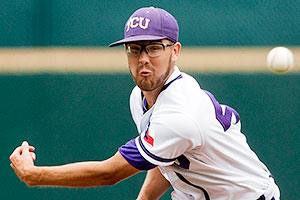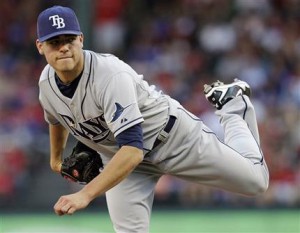Player Killers. Arm Shredders. Arm Abusers. There’s more than a few college coaches/programs out there who are known for it.
Its always dangerous to make a blanket statement in baseball. If I say that “CollegeX is known for killing pitcher arms” then there’ll immediately be people who cite players who are exceptions to such a rule.
Nonetheless, while reading a ton of prospect-driven content on the web over the years, some common themes pop up. And the crux of it is this: there are some college baseball programs out there that are accused of hurting their players’ professional prospects and draft statuses by virtue of the misguided or (in some cases) outdated coaching and usage of players.
Grantland’s Michael Baumann wrote an excellent article summarizing some of the “danger programs” in 2013, citing work done by Rany Jazayerli and Baseball Prospectus. Some of this also comes from Keith Law‘s freely offered opinions on the topic, and he offers up plenty of supporting evidence in his columns and chats. Some of these are “arm shredder” programs, others are places that are thought to change player’s swings.
Here’s some trouble-maker programs (and by “programs” often times by implication you’re blaming the head coach as the decision maker):
- Stanford: Law calls it the “Stanford Swing.” Per Law, Stanford coaches emphasize going away, altering hitters’ swings to de-emphasize pull hitting, to the point apparently where players are outright benched for pulling the ball. Now, there’s quite a few Stanford grads in the Majors right now, and the hitters listed aren’t exactly an honor roll of top-hitting guys. Jed Lowrie might be the best active hitter. The career Stanford grad homer leader is the recently retired Carlos Quentin, out of baseball at 32. So maybe there’s something to it.
- TCU: Jim Schlossnagle is not well known for its handling of pitchers. The Nats are well aware of this, having drafted damaged goods in Matthew Purke, who was 15-0 as a freshman and basically hasn’t been the same since.
- Rice’s Wayne Graham: Law has provided an exhaustive list of pitchers who he accuses the Rice coaches of blatantly over-working and has flat out suggested that pitchers considering attending Rice should go elsewhere. In fact, the most blatant example of this was the 2004 draft: Rice had three starters drafted in the first 8 picks (Philip Humber, Jeff Niemann, and Wade Townsend) and ALL three of them suffered shoulder injuries soon there after.
- UNC‘s Mike Fox so over-used a reliever a few years back that the New York Times of all papers wrote about it. And he had Matt Harvey, don’t forget, allowing Harvey to throw an astounding 157 pitches in a 2010 outing and 5 other instances of 120+ pitches. Is it a coincidence that Harvey blew out his UCL just a couple years later? Causation or Correlation?
- South Carolina‘s Ray Tanner: won back to back CWS’s … on the backs of his pitching staff.
- Texas‘ legendary coach Augie Garrido already had a reputation for overuse before the infamous Texas-Boston College regional game in June of 2009. Texas’ Austin Wood, a reliever, came out of the bullpen to throw 13 innings and 169 pitches in the 25-inning game. Garrido really took a lot of heat for that … but his BC counterpart might have only been slightly less culpable. BC threw its own guy Mike Belfiore for 129 pitches and 9 2/3 innings. In Wood’s case, it was made even worse by the fact that he had thrown two innings *the day before.* It is no surprise to report that Wood had to undergo Shoulder Surgery the next season, nor is it a surprise that the crusty Garrido disclaimed any responsibility for the injury by Wood’s usage in that game. Belfiore, it should be noted, has never shown any evidence of injury, was a 1st round draft pick just prior to his appearance, and looks like a 4-A pitcher who is now in the Detroit organization but who had a cup of coffee in 2013. Perhaps its because Belfiore was a starter and basically threw a start instead of Wood, who was clearly a reliever.
- UCLA: Look at the usage in college for guys like Trevor Bauer and Canning Griffith; is it any shock that these guys end up with injuries?
- Notre Dame: Not a good track record (per Keith Law) of developing or protecting pitchers.
Pitch count guidelines: there’s research out there that basically shows that anything above 120 pitches in an outing is an indicator of fatigue-induced regression their next time out, and 130+ pitch outings might as well be prescriptions for injury.
Times have changed: no longer are A-1 pitching prospects left in games to rack up ridiculous pitch counts. Mark Prior had at least 6 starts the year he was drafted where he threw 120-130+ pitches. Ben McDonald was famously started in back to back CWS games, getting clobbered in the second game … all while having *already* been drafted by the Baltimore Orioles, who must have been screaming at the television set watching what was unfolding as legendary LSU coach Skip Bertman set about destroying the best arm in the nation.
But then again, the more things change, the more they stay the same. NC State, in a mad dash to make the post-season in 2014, let their Ace starter Carlos Rodon throw 120+ pitches seven times. Rodon’s usage was also discussed in Baseball America. Did that lead to Rodon’s diminished stuff and subsequent drop in the 2013 draft? Maybe. I’m sure the White Sox are ok with it, since he doesn’t seem to have suffered any ill effects and is in their rotation 2 years later. Trevor Bauer, while at UCLA, *averaged* more than 120 pitches an outing the year he was drafted … but he seems like such an outlier because of his warm-up technique (which involves extreme long toss and clearly has built up his shoulder strength over the years). Are NC State and UCLA trouble-programs? I havn’t heard much since so i’m leaving them off for now.
Did I miss anyone?
Post Publishing update: we’re starting to hear more and more about UVA’s Pitching program being problematic; Per baseballdraftreport.com, only 3 of the 22 UVA pitchers drafted since 2009 have even made it to the majors, and the career UVA bWAR leader among all UVA players is a lefty reliever in Javier Lopez. UVA has had 42 players reach the majors and is one of the leading colleges for active players as we speak, but has had an awful track record of arms drafted recently. Just take a look at some of the recent top-end UVA arms drafted (from recent to older):
- Conner Jones: 1st round talent out of HS, slipped to 2nd round in 2016 thanks to regression during college career but no injury issues thus far in pro career.
- Nathan Kirby: supp-1st rounder in 2015: after just 5 pro games he needed Tommy John. Missed all of 2016 with injury, still not on an active roster as of Apr 2017.
- Josh Sborz; supp-2nd rounder in 2015: 2016 High-A all-star and 2017 NRI to Dodgers MLB camp. Starting in AA. One minor D/L trip. Was UVA’s closer/long reliever but starting in pro ball.
- Brandon Waddell: 5th rounder in 2015: quickly pitched his way to AA, where he spent most of 2016, suffered a forearm strain early in 2017.
- Nick Howard: 1st rounder in 2014, missed half of 2015 and 2016 with shoulder injuries, still in XST to start 2017.
- Artie Lewicki: 8th rounder/senior sign in 2014: missed parts of 2014 and 2016 on the D/L but active and in AA in 2017.
- Whit Mayberry: 21st rounder in 2014, already released by his drafting team (Detroit) and signed as a MLFA by Washington for 2017; currently in High-A. No injuries.
- Kyle Crockett: 4th rounder in 2013, raced through the majors and debuted for Cleveland in May 2014. No injuries.
- Scott Silverstein: 25th rounder in 2013, hurt in May 2015 and released after that season.
- Branden Kline: 2nd rounder in 2012, has been on the D/L since May of 2015.
- Danny Hultzen: #2 overall pick in 2011: massive shoulder issues, out of the game after throwing just 169 minor league innings in 6 pro seasons.
- Will Roberts: 5th rounder in 2011, has had a long minor league career; in AAA to start 2017.
- Tyler Wilson, 10th rounder in 2011, is currently Baltimore’s #5 starter.
So a couple of high profile injuries, but also some successes. I suppose the issues that their marquee 1st rounders has led to this reputation.
2018 update:
- Florida State let their starter (already having thrown 108 pitches) return to a game after a rain delay
- UConn getting a bad rap.



